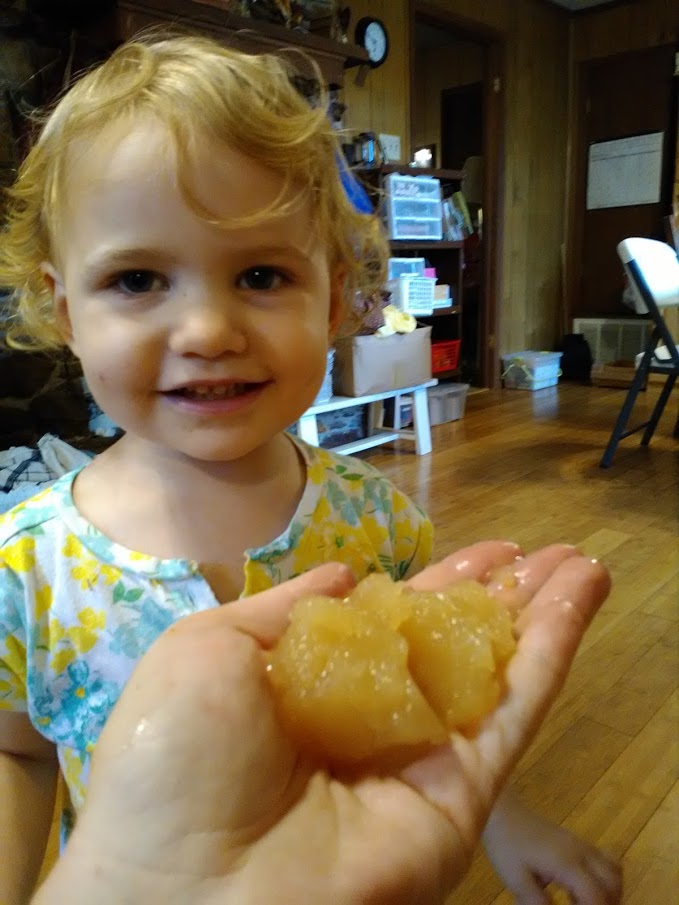Why Pasture-Raised Meats?
No Arsenic…
Last time, we talked about why we (Matt and Jerica) chose to pursue eating and producing animal products (meats, bones, fats, eggs, etc) because they are more nutrient-dense and digestible than vegetables. For a sick body, every bite counts, and for impaired digestion, those bites have to be highly digestible. Enter Animal Products.
With his ongoing and terrible flare-ups of ulcerative colitis, Matt could not tolerate the fiber and phytochemicals of raw, and even most cooked vegetable foods. So on his sickest days, he would eat homemade broth, white rice cooked with broth, whole milk yogurt, and pastured meats.

This pork broth was so gelatinous that I could carry it around in my hand!
Did he choose pasture-raised meats because they are humanely raised?
Nope.
Did he choose them because they are good for the environment?
Again, no.
Not saying those things are not good things, but his primary concern at the time was nutrients to heal his body. Matt needed the most nutritious food he could get into his belly. But he also needed to avoid harmful inputs that might contribute to his ailment. Hopefully another time, we’ll get to things to do with the environmental and stewardship issues, because those are certainly important. Hold on to your hat because we’re going to talk about some of the problems with conventional meats for consumers.
The first, and perhaps scariest, issue with conventional meats is the feed additives–the things they feed the animals that you are ultimately going to eat.
Harmful Feed Additives
This is not an exhaustive discussion of the problems, and today, I’m only going to address one aspect of the feeding practices of one species of farm animal. But you should know that, shockingly, EVERY time I dig deeper into the questionable practices of the conventional food industry, I discover new atrocities. That’s pretty scary considering how much I have already researched, and considering that I have been in “the industry” for over 8 years now!
Chicken with a Side of Arsenic?
The first additive I want to address is plain ol’ poison. Arsenic. Yep. It’s the stuff of fictional murder mysteries, and yet it is a common feed additive in poultry and pork production. Truth really is stranger than fiction! Why would they add poison to our food, you may ask. The answer: It’s mostly for efficiency and cosmetic reasons (read: profits and marketing reasons). It “pinks” up the poultry, which would otherwise have a disturbing grayish hue. It irritates their intestines causing them to eat more and get fatter faster. It also “helps” combat coccidiosis, a disease that can easily overtake a flock of chickens if they are kept in filthy, crowded conditions, and that last condition is the main one publicly cited as to why arsenic is added to our food’s food.
The justification when this began back in the 40’s was that, first, all the arsenic *should* be excreted in the feces [which are subsequently fed to dairy cows… or spread on organic produce fields! One way or another, the stuff never leaves the food system.]. Just in case it isn’t all excreted, it is the organic (as in carbon-based) form of arsenic, which is not nearly as toxic or potent as the inorganic form.
Fast forward 60 years when technology advanced enough to actually measure the arsenic in the birds’ tissues. Surprise! Arsenic was present at a much higher level than originally supposed. But it’s still the “less toxic” organic form, and so supposedly didn’t pose an immediate threat to consumers, so they quietly removed the first form (nitarsone) and replaced it with another (roxarsone). Eventually they “voluntarily recalled” that one, too, and it’s hard to say whether there is still a product widely in use since technically it’s not illegal, and being an organic compound, it’s pretty easy to come up with a new formula.
I won’t go into my concerns over how they actually did the testing to detect the poison in the meat or their justifications for allowing this to go on even after the testing was actually done, but I will say this: It is clear that for 60 years, the FDA allowed this practice to go on with no studies to prove its safety. Once there were studies that did question the safety, hardly any corrective action occurred, and organic arsenic may still be in use under a new name. Things haven’t changed much–if anything, the industry pressure on the FDA to allow all sorts of untested drugs is far worse now. In fact, a consumer petition to ban the use of organic arsenic in poultry feed was denied in 2013, even after the first recall, because the FDA was still trying to decide whether or not arsenic in poultry is dangerous.
It’s up to you to understand where your food comes from and how it is produced. Once upon a time, someone decided arsenic in chicken was safe, and they didn’t feel the need to tell you about it.
Think if you buy “organic,” you’re safe? If you search carefully on the organic poultry standards, it is mysteriously silent on the use of arsenic in livestock production. It is neither allowed nor prohibited. Does that mean they use it? Not necessarily. But it certainly doesn’t mean they don’t.

Broilers are moved daily to new pasture ground.
We control every ingredient in our chicken feed, and there is no arsenic. Our chickens take at least 2 weeks longer to grow than conventional, in addition to the increased labor it takes to move the birds to fresh ground daily. I know it’s a tough price point, paying 3-4 times as much for meat as you could. And I know cooking a whole chicken can be intimidating at first, especially when it’s so easy to grab one of those rotisserie concoctions from the local grocery store. But it’s important that we, as consumers, open our eyes and support the industries worth supporting. Every bite counts, not only for your health, but also for the success of the farms you care about.
Would you pay extra to know there’s no poison in your chicken? Know your farmer.


